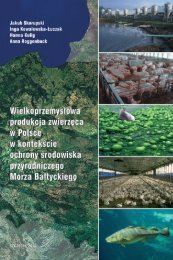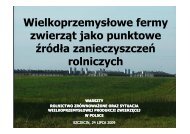best available technologies for manure treatment - Baltic Green Belt
best available technologies for manure treatment - Baltic Green Belt
best available technologies for manure treatment - Baltic Green Belt
Create successful ePaper yourself
Turn your PDF publications into a flip-book with our unique Google optimized e-Paper software.
Best Available Technologies <strong>for</strong> <strong>manure</strong> <strong>treatment</strong> baltic sea 2020<br />
Best Available Technologies <strong>for</strong> <strong>manure</strong> <strong>treatment</strong> baltic sea 2020<br />
ANNEX E: TABLES WITH SHORT DESPRIPTION OF LIVESTOCK MANURE TREATMENT TECHNOLOGIES<br />
Best Available Techniques <strong>for</strong> <strong>manure</strong> <strong>treatment</strong> - <strong>for</strong> intensive rearing of pigs in <strong>Baltic</strong> Sea Region EU Member States Technical Report "Best Practice Manure Handling, Phase 2"<br />
Ref No. 56A Ozonation<br />
Brief description<br />
Description of the effect on leaching<br />
(positive or negative) of N and P<br />
Ozone is a very powerful oxidising agent and reacts very rapidly with almost anything. Ozone must be produced locally because it<br />
is unstable and cannot be stored. Ozone is used as flocculant <strong>for</strong> the separation of <strong>manure</strong> by flotation. Methods <strong>for</strong> ozone<br />
<strong>treatment</strong> and separation of <strong>manure</strong> are being developed, and there are great expectations to the technology. Ozone <strong>treatment</strong><br />
combined with the flotation of the suspended material in the slurry <strong>for</strong>ms a clear liquid and a concentrated sludge. The fluid can<br />
then be further processed to a very high quality, while the sludge fraction should be handled as flotation sludge.<br />
Unidentified.<br />
The use of ozone can be applied <strong>for</strong> the remediation of nuisance odorous chemicals in liquid <strong>manure</strong>s. Gaseous ozone is bubbled<br />
directly into liquid <strong>manure</strong> in a continuously stirred batch reactor.<br />
Olfactometry determinations demonstrate a significant reduction in odours in ozonized samples as compared to raw and<br />
oxygenated samples, however, with big variation among technology suppliers. Volatile fatty acids, nitrate, phosphate and ammonia<br />
concentrations were unchanged by ozonation. The biochemical oxygen demand (BOD) and the chemical oxygen demand (COD) is<br />
essentially unaffected by ozonation, with the ozone concentrations tried.<br />
Ozone can be generated from oxygen in the atmosphere or by pure oxygen. Operating costs <strong>for</strong> the production of ozone is<br />
relatively high. Although it is theoretically possible to oxidize a very large portion of the organic matter in the slurry with ozone is<br />
not technically and economically feasible.<br />
Innovation stage<br />
Investment price, <br />
Basic Variable<br />
Operational<br />
costs,<br />
per tonnes<br />
per kg<br />
saved N or P<br />
leaching<br />
Complexity of<br />
implementation<br />
Research<br />
Pilot<br />
No data No data No data<br />
Practice <br />
Major references Condition <strong>for</strong> leaching reduction effect Certainty of in<strong>for</strong>mation<br />
N/A<br />
Low – can be<br />
installed at every<br />
farm<br />
CBMI N/A<br />
Prices High<br />
Effect on leaching High<br />
75<br />
Page 77<br />
75








